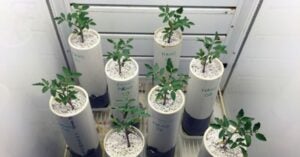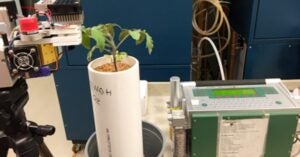With much of the Western United States still under drought, farmers know that heat stress and drought are hard on plants. But what, exactly, is happening to the plants under these conditions, and what can we do about it? These questions are becoming ever more urgent as we move toward a future with more carbon dioxide in the air, more heat, and more erratic weather.
Agricultural Research Service researchers are exploring how plants respond to these stresses, using tomatoes as the first test subject.
Tomato plants are often grown in greenhouses because they are considered a high-cost, high-value crop. Jennifer Boldt is a research horticulturist at the Application Technology Research Unit in Wooster and Toledo, Ohio, who studies crops grown in controlled environments, such as high tunnels, greenhouses, indoor vertical farms in warehouses, or shipping containers.
“The idea behind this research is that we are asking, ‘How do different environmental conditions potentially affect how nutrients are taken up by the roots of the plant, and what implication does that have for plant growth or the quality of the plants that are being grown?'” she said.
Previous research showed that conditions like heat, elevated carbon dioxide, and drought change how plants function. Still, there was little research on how the combination of those conditions affects them.
“Under my purview, we were able to say, ‘Let’s not look at one factor individually, but what happens when we have multiple factors that are changing at the same time — high temperature and high CO2, or drought and high CO2,'” explained Boldt. “Under that combination of drought and CO2, the plants couldn’t take up nutrients as much, so we had lower levels of nitrogen and phosphorus in the leaves. Nitrogen is a key component in proteins, and so if you have less nitrogen, then the plant is not going to be as green, and it’s going to grow more slowly, and any edible portion of the plant is going to be less nutritious.'”
The reasons for that reaction are a function of the plant’s response to changed conditions. Boldt explained that, under current CO2 conditions, plants grow and take up nitrogen at a specific rate, creating a balance. However, under high CO2, the plants grow more, but they’re not necessarily taking up more nitrogen at that same elevated rate. Hence, the result is a higher carbon-to-nitrogen ratio in the plant.

“It appears that the nitrogen concentration has gone down, but it’s just because the plant has put on more bulk more quickly,” she said, “because it’s taken that CO2 and turned it into sugars and structural components in the plant.”
To perform the research, Boldt collaborated with colleagues from the University of Toledo. The team wanted to understand more about why they were seeing lower rates of nitrogen uptake.
They knew that nutrients in the plant tissues could be affected by environmental conditions. Still, they didn’t know whether it was because the plants were taking up fewer nutrients from the soil or because things were going on within the plant that prevented the nutrients from moving up to the top part of the plant where they could be utilized.
They found that under the combination of elevated CO2 and heat, the leaves of their tomato plants were oriented much more vertically than under current conditions. Typically, the horizontal leaf position helps plants capture sunlight well. When, in response to stress, the leaves turn up vertically, they capture less light and ultimately, said Boldt, “aren’t able to utilize all of their systems as efficiently.” One result of that decreased efficiency: relatively less nitrogen.

The next question was whether or how these results might translate to other plants, especially commodity crops. Boldt decided to look at plants typically grown as field-based crops to find out. She examined changes’ effects on barley, corn, and big bluestem (prairie grass). In all cases, she found that the combination of conditions inhibited nutrient uptake, with some variation by type of plant.
Given these findings, what can farmers do to support their crop plants? Boldt’s research showed that the problem was not in the plant’s ability to take nutrients from the soil, so adding more fertilizer is unlikely to help. Instead, the issue is what the plant does with nutrients as it captures them.
To address that, farmers need plants that operate differently; Boldt suggests that looking to breeders may be the best approach. The ultimate goal, then, is that her research could lead to the development of plants that can better manage the distribution of nutrients as plants face hotter growing conditions with more CO2 and drought.
»Related: Perspective: Don’t blame cattle for climate change


